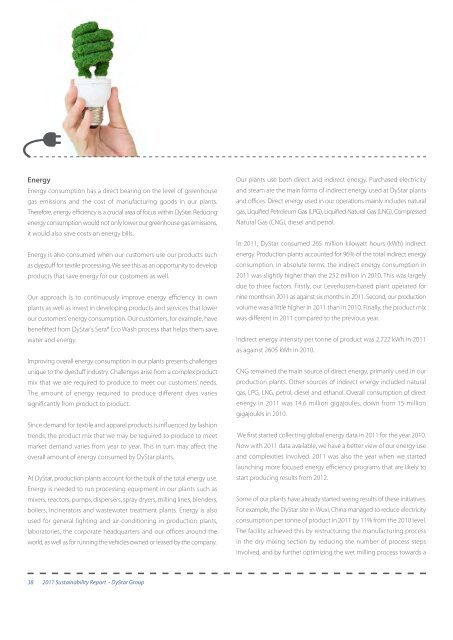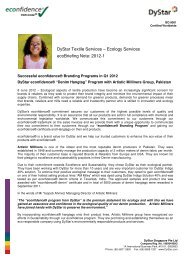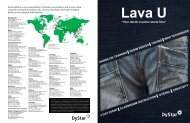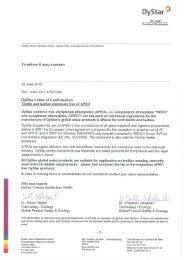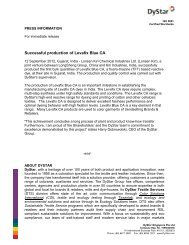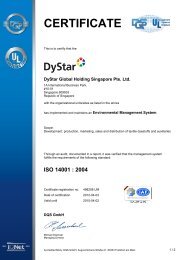Read the DyStar Sustainability Report 2011...
Read the DyStar Sustainability Report 2011...
Read the DyStar Sustainability Report 2011...
Create successful ePaper yourself
Turn your PDF publications into a flip-book with our unique Google optimized e-Paper software.
Energy<br />
Energy consumption has a direct bearing on <strong>the</strong> level of greenhouse<br />
gas emissions and <strong>the</strong> cost of manufacturing goods in our plants.<br />
Therefore, energy efficiency is a crucial area of focus within <strong>DyStar</strong>. Reducing<br />
energy consumption would not only lower our greenhouse gas emissions,<br />
it would also save costs on energy bills.<br />
Energy is also consumed when our customers use our products such<br />
as dyestuff for textile processing. We see this as an opportunity to develop<br />
products that save energy for our customers as well.<br />
Our approach is to continuously improve energy efficiency in own<br />
plants as well as invest in developing products and services that lower<br />
our customers’ energy consumption. Our customers, for example, have<br />
benefitted from <strong>DyStar</strong>’s Sera® Eco Wash process that helps <strong>the</strong>m save<br />
water and energy.<br />
Improving overall energy consumption in our plants presents challenges<br />
unique to <strong>the</strong> dyestuff industry. Challenges arise from a complex product<br />
mix that we are required to produce to meet our customers’ needs.<br />
The amount of energy required to produce different dyes varies<br />
significantly from product to product.<br />
Since demand for textile and apparel products is influenced by fashion<br />
trends, <strong>the</strong> product mix that we may be required to produce to meet<br />
market demand varies from year to year. This in turn may affect <strong>the</strong><br />
overall amount of energy consumed by <strong>DyStar</strong> plants.<br />
At <strong>DyStar</strong>, production plants account for <strong>the</strong> bulk of <strong>the</strong> total energy use.<br />
Energy is needed to run processing equipment in our plants such as<br />
mixers, reactors, pumps, dispersers, spray dryers, milling lines, blenders,<br />
boilers, incinerators and wastewater treatment plants. Energy is also<br />
used for general lighting and air-conditioning in production plants,<br />
laboratories, <strong>the</strong> corporate headquarters and our offices around <strong>the</strong><br />
world, as well as for running <strong>the</strong> vehicles owned or leased by <strong>the</strong> company.<br />
38 2011 <strong>Sustainability</strong> <strong>Report</strong> - <strong>DyStar</strong> Group<br />
Our plants use both direct and indirect energy. Purchased electricity<br />
and steam are <strong>the</strong> main forms of indirect energy used at <strong>DyStar</strong> plants<br />
and offices. Direct energy used in our operations mainly includes natural<br />
gas, Liquified Petroleum Gas (LPG), Liquified Natural Gas (LNG), Compressed<br />
Natural Gas (CNG), diesel and petrol.<br />
In 2011, <strong>DyStar</strong> consumed 265 million kilowatt hours (kWh) indirect<br />
energy. Production plants accounted for 96% of <strong>the</strong> total indirect energy<br />
consumption. In absolute terms, <strong>the</strong> indirect energy consumption in<br />
2011 was slightly higher than <strong>the</strong> 252 million in 2010. This was largely<br />
due to three factors. Firstly, our Leverkusen-based plant operated for<br />
nine months in 2011 as against six months in <strong>2011.</strong> Second, our production<br />
volume was a little higher in 2011 than in 2010. Finally, <strong>the</strong> product mix<br />
was different in 2011 compared to <strong>the</strong> previous year.<br />
Indirect energy intensity per tonne of product was 2,722 kWh in 2011<br />
as against 2605 kWh in 2010.<br />
CNG remained <strong>the</strong> main source of direct energy, primarily used in our<br />
production plants. O<strong>the</strong>r sources of indirect energy included natural<br />
gas, LPG, LNG, petrol, diesel and ethanol. Overall consumption of direct<br />
energy in 2011 was 14.6 million gigajoules, down from 15 million<br />
gigajoules in 2010.<br />
We first started collecting global energy data in 2011 for <strong>the</strong> year 2010.<br />
Now with 2011 data available, we have a better view of our energy use<br />
and complexities involved. 2011 was also <strong>the</strong> year when we started<br />
launching more focused energy efficiency programs that are likely to<br />
start producing results from 2012.<br />
Some of our plants have already started seeing results of <strong>the</strong>se initiatives.<br />
For example, <strong>the</strong> <strong>DyStar</strong> site in Wuxi, China managed to reduce electricity<br />
consumption per tonne of product in 2011 by 11% from <strong>the</strong> 2010 level.<br />
The facility achieved this by restructuring <strong>the</strong> manufacturing process<br />
in <strong>the</strong> dry mixing section by reducing <strong>the</strong> number of process steps<br />
involved, and by fur<strong>the</strong>r optimizing <strong>the</strong> wet milling process towards a


